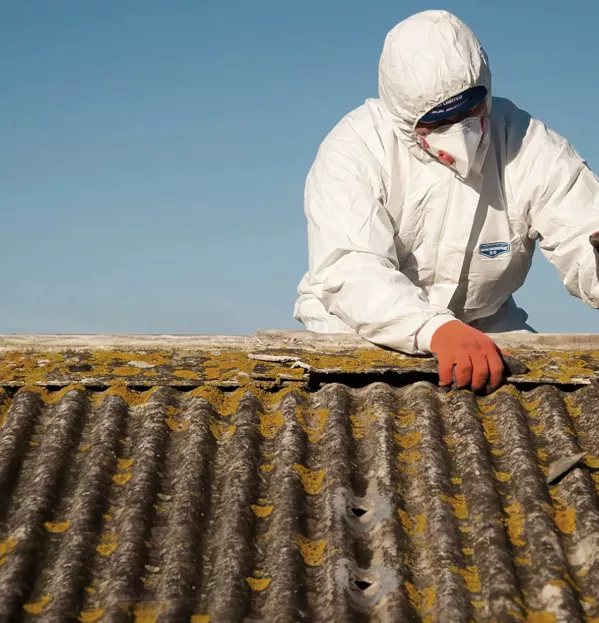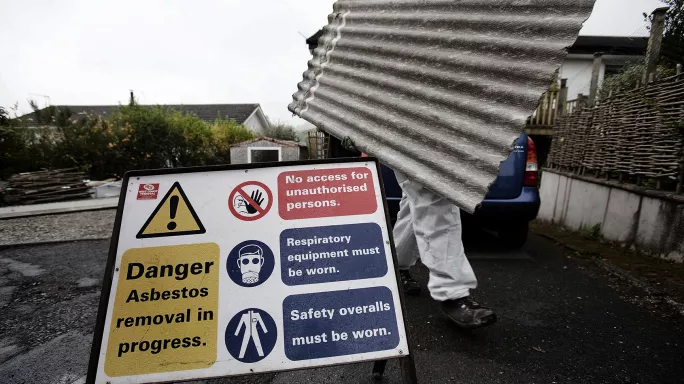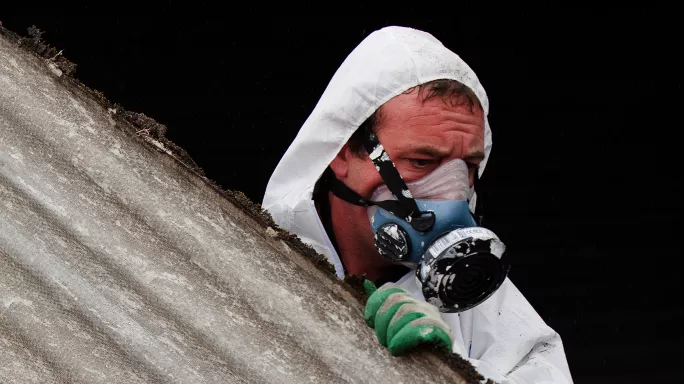Why asbestos remains a risk in school buildings

This article was originally published on 13 January 2023
Terry McLaughlin was a talented art teacher who worked in schools in Wiltshire in the 1970s and 1980s. By 2018, he had retired and was enjoying life with his wife, Jean.
But later that year, aged just 68, he died from mesothelioma, a mere six weeks after he was first diagnosed.
Mesothelioma is a rare form of cancer linked to asbestos exposure. Medical evidence determined he died from the effects of having inhaled asbestos dust while working at two schools in Wiltshire.
In October 2020, following a court case, his widow was awarded a payout from Wiltshire County Council for failing to keep him safe at work.
Just four months later, in February 2021, a 68-year-old former teacher from East Sussex called John Plater also died from mesothelioma. The council paid out £245,000 in compensation following a legal case brought by the family.
“Teaching ultimately led to his death, when in reality, he should have lived for another 20 years,” said his widow.
The danger of asbestos
The two cases are a sobering snapshot of the reality that asbestos - widely used as a fireproofing and insulation material during the 1960s and 1970s, including in school buildings - remains a real threat to teachers.
So much so, in fact, that in September, the Health and Safety Executive (HSE) started a programme of asbestos inspections in primary and secondary schools in England, Scotland and Wales.
“We understand parents, teachers and others who work in schools may be concerned about the presence of asbestos in school buildings,” said an HSE spokesperson.
The aim of the “inspection campaign”, they explained, is to ensure schools have “effective arrangements in place and are complying with the law”.
A likely drive for this was its own report from 2022 that acknowledged the risk to teachers was higher than for those in many other professions.
“Proportional mortality ratios are somewhat higher for teachers and administrative occupations than those for nurses, sales occupations and process operatives,” it said.
Overall, though, the advice was not to worry: “The risk of exposure is low as long as schools follow the regulations and have the right measures in place”.
Yet, the tragic cases of the two teachers above, and the fact the HSE is putting a focus on asbestos in schools, suggest this is an area of concern. So, what do schools and those working in them need to know?
What is asbestos and how does it cause cancer?
Asbestos is a general name for naturally occurring minerals that have crystallised to form fibres. These fibres are strong and heat resistant, which is why asbestos was used as fireproofing and insulation in buildings: in walls, ceilings and around boilers and pipes.
These fibres are also the means by which asbestos causes mesothelioma, a type of cancer that develops in the lining that covers the outer surface of some of the body’s organs, including the lungs.

“Fibres embedded in your lung cause the cancer,” explains Julian Peto, professor of epidemiology at the London School of Hygiene and Tropical Medicine, who studies asbestos-related cancer and last year gave evidence as an expert witness to the House of Commons Work and Pensions Committee inquiry into the HSE’s approach to asbestos management.
He explains that when a cell has a fibre sticking in it, that interferes with cell division and can ultimately cause cancer.
Sadly, for many years, this was unknown and the material was widely used in the UK and around the world. Over time, though, the link between products that contained asbestos and the dangers posed became clear and it was slowly outlawed in many countries - with Denmark, Sweden and the US doing so from the 1970s.
The UK took longer, though: the first bans came into force in 1985, with asbestos being banned in its entirety from as recently as 1999.
How many schools have asbestos?
Asbestos is widespread in school estates. A Department for Education survey in 2019 found that asbestos remains present in between 71.6 per cent and 83.1 per cent of the English school estate.
This is chiefly because asbestos was widely present in prefabricated school buildings constructed under the Consortium of Local Authorities Special Programme (CLASP) that started in 1957, from which around 3,000 schools are still in use.
‘Asbestos materials present little risk if they remain undisturbed’
“With the post-war population boom, the number of schools in the UK needed to increase,” explains John Richards, managing director of Thames Laboratories, which specialises in the surveying, identification and analysis of asbestos-containing materials.
“Asbestos was a widely used material in these types of properties due to its ease of manufacture and properties and, as a result, is widespread in the education estate.”
How many teachers have died from mesothelioma?
Professor Peto explains that mesotheliomas are rare below the age of 60 and asbestos causes very few mesotheliomas within 40 years of starting exposure. As such, it’s only been in the past 20 years that the impact on those exposed to asbestos in schools has become clear - with tragic results.
Data from the Office for National Statistics (ONS) shows that 305 former teachers were confirmed to have died from mesothelioma between 2001 and 2016.
The true number is probably far higher, according to an academic paper, led by Bethany Taylor, a research fellow at the University of Sheffield’s Mesothelioma UK Research Centre.
The ONS data, says the paper, does not record the occupation of the deceased for over-75s; only records the final occupation of the deceased, meaning teachers who went onto other careers will be excluded; and excludes other school staff such as caretakers, cleaners and kitchen workers who would have worked in the same environments filled with asbestos.

What’s more, given that it generally takes until someone passes age 60 for mesothelioma to become present, there could well be another generation of teachers at risk.
The same is true for pupils who have been in asbestos-riddled schools: “The kids who were in school at the time it was being installed must have been exposed as well,” notes Professor Peto.
How at risk are current teachers and pupils?
It’s important at this point to consider levels of risk. Andrew Paten, co-founder of UK National Asbestos Register (UKNAR), explains that, though asbestos is widespread in schools, the dangers it poses are very variable depending on the state of the school in question.
“Yes, 75 per cent or so of schools have asbestos…but about 25 per cent of those schools are really bad, then there’s another 60 per cent or so that need to be managed carefully, while in the rest the risk is fairly limited,” he explains.
What’s more, even in the most dangerous schools, there are ways to minimise these risks - the simplest of which is simply to leave asbestos well alone: “Asbestos materials present little risk if they remain undisturbed,” notes Richards.
It’s advice the HSE is happy to give, too: “If asbestos is present, as long as it is undisturbed, sealed and closely monitored, it can be safely managed in situ,” says the spokesperson from the HSE.
This is because the fibres in the asbestos are more likely to be inhaled and therefore risk damaging someone’s lungs if they are released into the air.
However, Phoebe Osborne, a senior associate in the specialist asbestos team at law firm Hugh James and chair of the East of England Asbestos Patient Support Group, says that, as many teachers will know, a school is a “robust” environment, which means the HSE’s advice above may not always hold.
“Asbestos might have plasterboard over it, but that banging and wear and tear and people basically breaking the fabric of the building, that’s going to release asbestos,” she argues.
Teachers, meanwhile, often put holes in walls or ceilings to hang displays that could disrupt asbestos without them knowing that it is present.
“In-situ management is difficult in schools, where levels of wear and tear are high,” Professor Taylor noted in her academic paper.
What should schools be doing to mitigate risk?
Schools are meant to have detailed documentation that makes it clear where asbestos is situated to try and avoid the risk of it being disturbed, as set out in the Control of Asbestos Regulations 2012 that schools are subject to.
Amy Neeves, head of estates and capital programmes at the David Ross Education Trust, who has responsibility in this area, says these sorts of surveys are vital.
“[This will mean] you understand the current condition, you are managing the risk and, consequently, annual removal or encapsulation costs can be well managed,” she says.
Schools should keep this information in an asbestos register that can be checked by any contractor - or indeed staff member - wishing to understand where asbestos is present.
“Teachers and contractors are supposed to be informed of where asbestos is present, especially if there any risk of disturbing it,” explains Paten at UKNAR.
However, he says the reality is the “line of sight” of these registers is often poor, with people unaware they are available or the data they contain is too opaque to be of real use.
“The information is often lengthy or in an incomprehensible format for a layperson. We’ve had contractors saying they give up asking for it because it’s just not helpful or they’re just asking for the register as a tick-box exercise,” says Paten.
Learning of this situation through his work as a fire safety expert, Paten realised there was scope to bring a tool to market to help improve this by digitising information in a school’s asbestos register into an online format so teachers or contractors could easily access it.
‘The cost of completely eradicating asbestos is so high that it would never be possible’
So, in 2020, UKNAR launched a platform called Asbestos SMART, which is designed to provide quick and easy access to asbestos information.
“We take information [from a register] and upload it. Then it can be accessed by scanning a QR code so you can see the asbestos registered in the school for a certain zone before any work begins.”
He says this means it should be far easier for anyone to understand the risks that may exist and where to avoid disturbing asbestos.
There is a fee for using the platform - generally between £200 and £500 per school per year - but the organisation operates as a social enterprise, mostly using the fees to cover its operating costs. It is also a partner organisation to the charity Mesothelioma UK.
To date, more than 120 schools are using the platform, including 16 multi-academy trusts. A further 60 or so trusts are also evaluating a rollout of the platform, too.
One of those early adopters is Mike Wells, estates and facilities manager at the Pathfinder Multi Academy Trust in York, which is formed of 11 primary schools. He started using the platform in 2021.
“Dealing with the asbestos in our schools was cumbersome and very labour intensive - our asbestos surveys were up to 120 pages long and getting any contractor to look at that was a nightmare because obviously they’re working on time and want to get in and get the job done,” he tells Tes.
He says that now, though, because contractors can just scan a QR code and be shown the relevant pages showing where asbestos is present, it saves a lot more time and reduces the risk.
Furthermore, it means that any tender documents for work can include the QR codes too, helping firms easily assess the asbestos situation and whether they have the skills to work around this.

“Tenders are a lot more productive because companies will look at it and either decide “yes” or “no” because of asbestos,” he explains.
“This means we’re not getting any hidden costs coming up when contractors say, ‘We didn’t know about that asbestos when quoted so your costs have now gone up’.”
Given that one project to replace some boilers at a Pathfinder school required four weeks of additional work simply to remove the asbestos while the school was closed in the summer holidays, this is no small matter.
Creating a database of asbestos locations in public sector buildings akin to what UKNAR has built was actually something the Commons Work and Pensions Committee proposed in 2021 but it was rejected by the HSE, a decision Mesothelioma UK CEO Liz Darlison said was “hugely disappointing”.
Through all this, many will be thinking: why can’t schools just have the asbestos removed?
Why is asbestos not being removed from all school buildings?
Sadly, it is an extremely expensive thing to do: the DfE estimates it would cost £100 billion to remove all asbestos from schools, according to a 2017 Public Accounts Committee inquiry on capital funding for schools.
“The cost of completely eradicating asbestos is so high that it would never be possible,” acknowledges Neeves.
Even Osborne, whose work regularly sees her support mesothelioma patients, carers and bereaved families, does not think aiming to remove it all is viable.
Instead, she says a focus has to be given to removing it from the most high-risk areas: “There should be a priority of removing asbestos insulation board from areas of heavy use, like stairwells.”
Pipe lagging and boiler houses are also potential problems that should be targeted for removal, she adds.
She says the government could help by allocating funding specifically for this type of work - a point Neeves agrees with by noting that at present, any funding for building improvements can be swallowed up by asbestos removal.
“Projects such as fire safety works or window replacements can often almost double in cost when you add in the price to remove the asbestos,” she says.
“This can ultimately have a real impact on a trust’s ability to deliver necessary improvement works to the extent they need to.”
Would more cash be forthcoming, though, in these financially tough times?
The DfE told Tes that, as part of various funding channels for schools for building improvement work, £13 billion has been committed since 2015 that can help with this.
“This funding can be used to remove asbestos as part of wider refurbishment works,” it said.
‘The government must fund the phased removal of asbestos, solving the problem once and for all’
Meanwhile, its Condition Data Collection 2 exercise is currently under way. This aims to assess the state of education buildings in England by visiting every school and college by 2026 and will include data on the scale of asbestos and how it is being managed to help inform future policies.
“We follow HSE’s expert advice on asbestos and regularly review our guidance to support local authorities, governing bodies and academy trusts to have robust plans in place to manage asbestos in school buildings effectively, in line with their legal duties,” the DfE added.
But for the unions, more action needs to be taken.
So much so that, in 2010, unions including the NAHT school leaders’ union, the NASUWT teaching union and University and College Union formed the Joint Union Asbestos Committee (JUAC), whose “ultimate goal is for a government-funded phased removal of all asbestos from educational buildings, starting with the most dangerous first”.
Geoff Barton, general secretary of the Association of School and College Leaders - another of the unions in the JUAC - says the need to act remains as high as ever.
“As long as asbestos remains in school buildings, there is always the risk of it being disturbed and damaging the health of pupils and staff.
“The government must fund the phased removal of asbestos from all schools and colleges, solving the problem once and for all and ensuring all children and young people have a safe environment in which to learn.”
Given the huge costs involved, though, this seems unlikely to happen any time soon.
However, what could help make that case more urgent would be a greater insight into just how damaging to the health of current staff and children the continued presence of asbestos is in schools.
To this point, Professor Peto is planning more research on the level of exposure for teachers who started work after 1980, when asbestos installation drastically declined, to measure exposure rates.
“Any teacher starting work after 1980 shouldn’t have had higher exposure than anyone else,” says Peto.
“[So this study] will tell you whether schools went on being dangerous after 1980.”
If the study does find this was the case, many will argue that it shows why asbestos must be proactively removed - even if it generates a huge bill. The economic reality may still mean the “leave well alone” argument wins out, however.
Sadly, though, as the coroners’ reports mentioned above attest, that could mean the legacy of asbestos in schools is more suffering and premature deaths.
“This isn’t a new problem,” laments Osborne. “In the decade I’ve been doing this work, not much has changed. More people have died.”
John Morgan is a freelance writer. Additional reporting by Dan Worth, senior editor at Tes
Keep reading for just £1 per month
You've reached your limit of free articles this month. Subscribe for £1 per month for three months and get:
- Unlimited access to all Tes magazine content
- Exclusive subscriber-only stories
- Award-winning email newsletters



